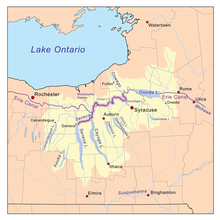|
Seneca River (New York)
The Seneca River flows 61.6 miles (99.1 km)[3] through the Finger Lakes region of Upstate New York in the United States. The main tributary of the Oswego River – the second-largest river flowing into Lake Ontario – the Seneca drains 3,468 square miles (8,980 km2) in parts of fourteen New York counties. The Seneca flows generally east, and is wide and deep with a gentle gradient. Much of the river has been channelized to form part of the Erie Canal. GeographyThe Seneca River begins at Geneva in Seneca County, as the outflow of Seneca Lake,[6] flowing east past Waterloo and Seneca Falls. Skirting the northern end of Cayuga Lake at the Montezuma Marsh, it turns north, receiving the Clyde River from the west, forming the Seneca–Cayuga county line, then the border of Cayuga and Wayne counties. The river passes under Interstate 90, flowing northeast past Weedsport, across the middle of Cayuga County into Cross Lake.[7][8] Below Cross Lake, the Seneca River enters Onondaga County. It turns sharply north then east, past Baldwinsville and Liverpool, along the northern edge of metro Syracuse where it receives the outflow of Onondaga Lake. The river then flows north to join the Oneida River at Three Rivers on the Onondaga–Oswego County line, forming the Oswego River. From the confluence, the Oswego flows a further 23 miles (37 km) north, emptying into Lake Ontario at the city of Oswego.[8][9] The Seneca River watershed drains a total of 3,468 square miles (8,980 km2), or about two-thirds of the greater Oswego River basin.[4] There are about 4,370 miles (7,030 km) of streams in the Seneca basin.[10] The Seneca receives the outflow of seven of the eleven Finger Lakes: Canandaigua, Keuka, Seneca, Cayuga, Owasco, Skaneateles and Otisco. Canandaigua Lake flows via the Canandaigua Outlet and the Clyde River into the Seneca River. Keuka Lake empties into Seneca Lake via the Keuka Lake Outlet. Owasco and Skaneateles Lakes join the Seneca through their eponymous outlet streams, while Otisco Lake flows via Ninemile Creek into Onondaga Lake, which in turn empties into the Seneca.[8] TributariesLeft Right HistoryNative Americans
The river is named for the Seneca people, whose traditional lands extended roughly between Lake Erie and Seneca Lake.[11] The Onondaga inhabited the area in present-day Onondaga County, around Onondaga Lake and Syracuse, and the Cayuga inhabited the river valley and lakeshores in between. All three were part of the Iroquois League, which is believed to have been established between 1570 and 1600.[12] For hundreds of years before the arrival of Europeans, the river was an important Native American trade route.[13] Explorers and settlers
The first Europeans to reach the Seneca River were likely Jesuit missionaries in the late 1600s, who established an outpost, St. Stephen, on the river shortly below its origin at Seneca Lake.[14] CanalizationIn 1821, the Seneca Lock Navigation Company completed eight locks along the upper Seneca River above Cayuga Lake to allow navigation to Seneca Lake. By 1828, this had been replaced by a state-owned waterway, the Cayuga-Seneca Canal, which contains eleven locks in 21 miles (34 km).[15] Construction of the Seneca reach of the Erie Canal began in the 1820s. The channel between Three Rivers and Cayuga Lake was widened and straightened to accommodate barges, and other reaches were bypassed via the construction of parallel canals. The canal path had to cross the Seneca River at several points, so locks were built to lower boats down to river level, where they were towed across aided by temporary wooden bridges. In 1849 work began to separate the canal from the river, to reduce the impact of flooding and sedimentation.[16] The Montezuma Marshes at the outlet of Cayuga Lake were a major obstacle to the Erie Canal path. The stone Seneca River Aqueduct (Richmond Aqueduct), which carried the canal over the Seneca and Clyde Rivers, opened in 1857 after eight years of construction. At 840 feet (260 m) it was the second-longest aqueduct on the Erie Canal system.[17] Most of the aqueduct was dynamited in the 1910s to allow navigation on the Barge Canal.[15] Certain points on the Seneca River were an early center of development for industry. Seneca Falls is the location of the only significant natural drop on the river, which was utilized in the early days to power water mills. Where the river had no natural falls, mill dams were built, one of the earliest of which was at Baldwinsville. In 1915 a dam 80 feet (24 m) high was built at Seneca Falls to generate hydroelectricity.[18] Ecology and environmental issuesBelow Onondaga Lake, the Seneca River is moderately polluted by industrial and domestic waste, including high levels of mercury, PCBs, dioxin and ammonia. The New York State Department of Health advises limited consumption of fish from the lower river.[19] Parts of the river are infested by non-native zebra mussels, which have depleted the level of dissolved oxygen, impacting fish populations. The population density of mussels in one particular section of the river below Cross Lake is considered among the highest in North America.[19] The river is home to a population of common snapping turtles. In July 2001, there was a recorded attack on a 43-year-old man, near Fobes Island, who sustained minor injuries to the calf of his leg. This has been the only recorded attack on humans in the river so far.[citation needed] See alsoReferences
External links
|
||||||||||||||||||||||||||||||||||||||||||||||||||||||||

